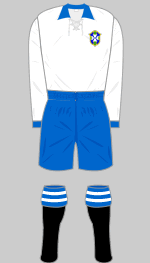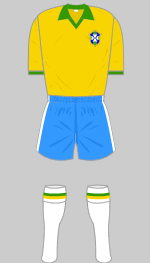With the exception of the FIFA Confederations Cup and the CONCACAF Gold Cup, the 2012/13 season is all wrapped-up. We already have covered the jerseys worn at the Confederations Cup and I want to wait for the new season’s jerseys until that season actually starts somewhere mid-July. So, why not do something different to bridge the gap? I decided to start a new feature: History of Classic Soccer Shirts: for an extended period, I will pick one type of jersey (home or away) of a famous team and look at its evolution over time. The first article of the series will always cover the shirts worn roughly up until 1986 (sometimes the cut will be sooner, sometimes later depending on how reliable information I can get about the manufacturer) to give you, the reader, an idea of how the shirt actually evolved and what the classic look was. Then, we will run through the recent kits one by one and I will dish out ratings as usual. The source for these historic shirts are old photographs gathered all over the internet, the excellent site Historical Football Kits as well as Classic Football Shirts, which has already been my source for previous articles. Enjoy!
Let’s start this new feature with the most famous soccer team in the World: the Brazilian team. Not only are Brazil the most successful nation in World Cup History and are hosting the upcoming World Cup, they also have one of the most interesting stories regarding their uniform. Pictured below are the World Cup kits from 1930, 1934, 1938 and 1950. Anyone only remotely interested in soccer will wonder why these kits are white and not yellow. Also, where is the green? Well, as you may guess Brazil played initially in white shirts with some blue accents, mostly the collar. Between WWI and WWII this shirt was worn with blue shorts and black socks. I can only speculate about the choice of the color, so I won’t delve on the subject. Fact is that after WWII, the kit was revamped into an all-white kit with dark blue collar and trims on sleeves and shorts. And if it wasn’t for that one game against Uruguay on July 15, 1950, Brazil would still wear these colors.
However, in the wake of this epic and monumental defeat, people found the white jersey not only very un-Brazilian (just look at the flag), but also deemed it unlucky. A change had to be made and the newspaper Correio da Manhã held a competition for a new look of the Brazilian national team based on the national colors. The winning entry was provided by Aldyr Garcia Schlee a teenager at the time who (as legend has it) grew up in close proximity to Uruguay and thus had sympathies for the team that initiated the change. Thus, probably the most famous soccer uniform in history was born: yellow shirt with green trims, blue shorts with white trims and white socks with yellow-green bands. The kit debuted in 1954 (in the meantime Brazil wore a blue uniform) and has been worn ever since. Below are the kits from 1954, 1958 (winner), 1962 (winner) and 1966.
As we can see during this initial period, the shirt looked pretty much the same, the only slight variations coming from the green shirt collar, which had a green trim on the opening except for the 1958 World Cup (another side note: in the 1958 World Cup Final Brazil could not wear their traditional yellow kit since opponent and host Sweden also played in yellow and blue. A blue uniform was bought hastily and thanks to the victory have been used as alternate uniforms ever since – although blue kits have been used previously).
The first real change came just in time for the 1970 World Cup in Mexico (the first to be broadcast in color and by many considered to be the best of all time): The green shirt collar was replaced by a green round collar and was worn by one of the best and most exciting teams of all time featuring of course Pelé at the center – he World Cup was won in style for the third time and Brazil was allowed to keep the Jules Rimet trophy. While the shirt collar has a longer tradition it is this round collar version, that many consider to be the classic one (see below a version signed by Pele). Also note, that there are no stars for the previous two World Cup victories since that practice was not yet in use.
That changed for the 1974 World Cup in Germany where a sub-par Brazil team finished fourth, but was still wearing that classic uniform. This time, though, three stars were added to the CBF crest and a tradition had begun.












Pingback: Brazil (Home 2014) | My Soccer Universe
Pingback: Brazil (Away 2014) | My Soccer Universe
Pingback: (West) Germany (Home 1908-1985) | My Soccer Universe
Pingback: Brazil (Home & Away 2019) | My Soccer Universe